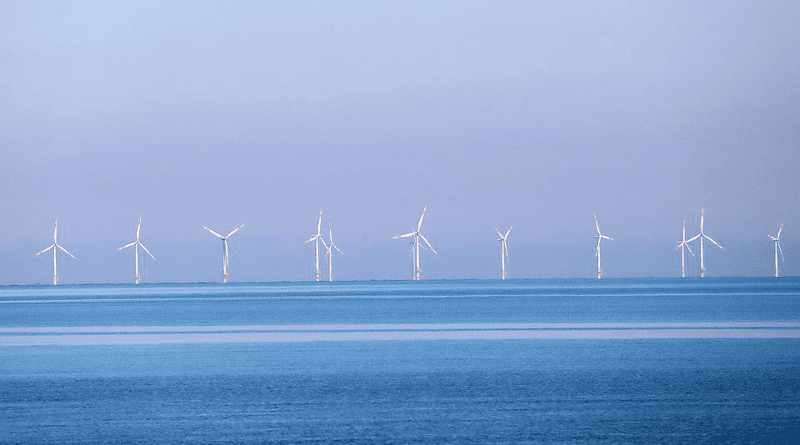EU: €400bn Needed For Offshore Grids By 2050, Network Operators Say
By EurActiv
By Frédéric Simon
(EurActiv) — Europe’s first-ever Offshore Network Development Plan, published on Tuesday (23 January), highlights the huge investment needed to connect offshore wind farms to final consumers, with an estimated 54,000 kilometres of transmission assets expected to be built in European waters by 2050 – almost 1.5 times the equator’s length.
The European Commission has set an aspirational target of building at least 60 gigawatts (GW) of offshore wind capacity by 2030 and 300 GW by 2050 as part of its 2020 offshore renewable energy plan.
Those targets are exceeded in the first-ever Offshore Network Development Plan published today by ENTSO-E, the association of European transmission system operators who are running the electricity grids in each country.
According to national data compiled by ENTSO-E, EU countries have up to 354 GW of offshore renewables in the project pipeline by 2050, a figure that goes up to 496 GW when adding Norway and the United Kingdom.
But connecting those offshore wind farms to final consumers will not be cheap, the report warns.
“A total investment of upward of €400 billion will be needed for the offshore transmission assets,” ENTSO-E estimates, saying the infrastructure needed to connect those “might cover up to 54,000 km of routes in European waters, equal to almost 1.5 times the length of the equator”.
Kadri Simson, the EU’s Energy Commissioner, welcomed ENTSO-E’s offshore grid development plan, saying it “mirrors the direction set by the EU” and makes existing European offshore energy plans “even more ambitious” thanks to the contribution of EU member states.
WindEurope, a trade association, hailed the plan as “a significant step forward,” with CEO Giles Dickson saying it will “help people decide how best to build out offshore grids” and identify bottlenecks.
Challenges
Yet, the European grid operator association acknowledges that building those assets will be challenging.
“Bringing this energy to the shore is only half of the story, it also needs to be brought to the people who are going to consume it,” said Damian Cortinas, chair of ENTSO-E’s board. Moreover, “planning the network is also half of the story because you then also need to build it,” he told journalists during a briefing on Tuesday (23 January).
Topping the list is financing, according to Cortinas: “The money exists. The issue is how we make it available, attractive, and in a way that will be there when we need it.”
Key to keeping costs down is “the availability of commercially attractive DC-circuit breakers,” ENTSO-E says.
“If we’re going to make it more complex – with more offshore wind farms connected to land – we can’t do this with today’s technologies, because if you have a fault, the whole structure will be down,” explained Gerald Kaendler, director of asset management at Amprion GmbH and chair of ENTSO-E’s system development committee.
“So we need circuit breakers that open the structure,” he added, saying these technologies are “more difficult to build” for technical reasons and “are not at industrial scale yet”.
According to ENTSO-E, additional interconnection capacity between EU countries is estimated at 13 GW with DC circuit breakers by 2040 but only 7.5 GW without them. Within EU countries, the needs are estimated at 13 GW with DC circuit breakers and 2 GW without.
Then come supply chain worries, including “supporting manufacturing capacity such as ships, yards, ports and harbours to assemble and deploy the equipment in the sea, and human resources to design, build and operate offshore systems,” ENTSO-E says.
Another bottleneck relates to supplies of critical raw materials that are needed to build the infrastructure, ENTSO-E adds, saying “the challenge ahead is huge as the offshore infrastructure market is now global and resources are scarce”.
Politics around grid access
Offshore wind farms are also often connected to more than one country, requiring closer coordination between governments, owners of generation assets and grid operators than traditional renewable energy projects.
“The politics around grid access and grid connections, especially hybrid grid connections, are complicated,” said Giles Dickson from WindEurope. “It’s essential to resolve the cost-sharing issue as soon as possible. Otherwise the EU risks missing out on investments,” he warned.
According to ENTSO-E, overcoming these challenges will require unprecedented cooperation between public authorities and the industry in a system-wide approach to grid planning and construction.
The good news is that EU policymakers are aware of those challenges. In November last year, the European Commission unveiled an action plan to accelerate the roll-out of electricity grids and remove bottlenecks hampering the deployment of renewables.
“The grid action plan is the political drive that we need to make this happen,” Cortinas said, referring also to a forthcoming European grid alliance announced by EU Green Deal commissioner Maroš Šefčovič at this year’s World Economic Forum in Davos.
“There are a lot of ideas there on how to finance, how to solve the supply chains constraints,” Cortinas said hailing the grid alliance as “an excellent idea”.
“It doesn’t mean it will be easy,” he added, referring to regulatory constraints caused by the creation of industry alliances, such as EU competition and antitrust rules. “But we think this is very timely and very useful,” he said.

